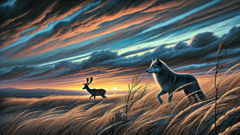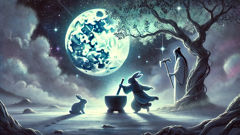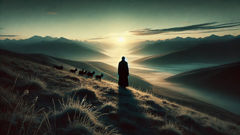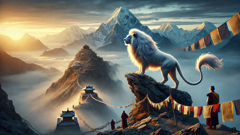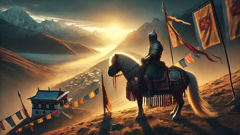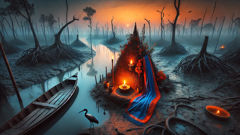Introduction
The steppe speaks in wind and hoofbeats. Under a ceiling of wind-blown clouds and the vast bright arc of day, grasses rise and fall like a living sea; the horizon has no corners and the colors keep changing, from winter's silver to summer's gold. In those early, unnamed years before clan or camp, the world was simpler and sharper: rock, sky, water, and wild creatures that read the weather better than any human. It is said that from that open plain, where the earth breathed and the sky answered back, came a meeting that would change the fabric of bloodlines. A blue-grey wolf, eyes rimmed with the hard light of the steppe, moved silently like a shade at dusk. In the same tall grass grazed a fallow doe, heart steady, ears tuned to the same ancient rhythms. They were not of a people's making; they were creatures in a land that had no owners, only keepers and transient guests. Yet when the wolf and the doe came together on a night when the stars seemed to tilt toward the earth, something coherent and unexpected was born: a child whose breath carried the scent of both moonlit fur and dew-soaked meadow. The child grew under the watching of the wind and the judgments of stars, taught by wolves how to read the sky and by does how to listen to grass. In time that child—part beast, part gentle herbivore—walked the steppe and gathered kin. Tribes would call themselves by the wolf, by the horse, by the sky-born names of ancestors, and through song and oath would remember that first meeting. This is the myth of how the Mongol people began: a story that does not aim at biography but at belonging, an origin told again and again by firelight, by mothers to sons, by elders to riders leaving camp, and by singers on the thresholds of battle. It is a tale shaped by wind and patience, and it wants to be listened to the way one listens to the weather—without hurry, with the living sense that the story might ask something of you and of a land that has been generous and terrible in equal measure.
The Steppe and Its First Witnesses
When the world was raw and the steppe still sang the names of creatures with no human words to soften them, life moved according to a grammar of weather and hunger. The wind—Tengri to later voices—breathed broadly and sometimes with a cruelty that sorted the herd from the weak. Rivers carved their slow signatures in the earth, and stone remembered the passing of hoof and paw. In that openness the blue-grey wolf lived as both shadow and sentinel. He was not merely a hunter; he was, in the terms that would later be given to ancestors, a seer. His coat caught the pale light of morning and the cool blue sheen of evening; his tracks were a map that knew where the wild thyme grew and where marmots had burrowed safe passages. He moved with a careful economy, conserving strength, reading the air for falcon or storm. The wolf's hearing was a thing of legend even among other creatures: a twig falling miles away was a question in his ear, and the answering silence could be a whole chapter of weather.
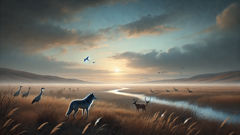
Across the grass, the fallow doe belonged to a different order of skill. Her life was tuned to caution and to the delicate mathematics of grazing. Where the wolf listened, the doe observed: the subtle tilt of grass blades signaling fresh water beneath, the slight clouding on a distant horizon that meant predators had moved through. Her movements taught a kind of patience; even when the herd scattered in a surprise gust, she could find the patterns that would bring them together. In the pale mornings she would stand, tail nervously flicking, but she had an inner steadiness, a capacity to carry new life in a season of storms.
The meeting of wolf and doe has been told many ways, in songs that shift detail and in tales that change tone with the storyteller's intent. What remains constant is a night when the stars seemed nearer than usual, so bright they cast the grasses into black and silver. Under such a sky the blue-grey wolf followed the scent of marrow and salt until he found the doe sheltered in a hollow near a river. She was not startled into flight; instead she held her place and met his gaze. In their eyes, storytellers say, the sky found a mirror. Theirs was not an ordinary crossing of paths. It was, the old ones said, a joining that owed itself to the deep kindness of the land and to the precise indifference of fate. Animals, humans, and the weather agreed—if not in language then in consequence—that something new had been allowed to begin.
Around them the steppe registered the anomaly. Cranes called from reeds in an odd cadence; wolves that had watched from ridges dipped into silence; even the wind slowed as if to listen. That is how the first chorus of witnesses is remembered: not as an audience of gossiping creatures but as a living catalog of the myths that would soon be needed. The animals understood that origins are heavy things, and origins change the obligations of migration, hunting, and shelter. Each bird and rodent, each stone and stream, made a small ledger entry in their own ways, promising to bear witness when the child of wolf and doe would later stand and claim a place.
For people who would later herd sheep and ride horses, the image of a wolf and doe meeting in grass served as a moral geography. It told them where to find courage and where to show mercy. The wolf embodied a stern, necessary power—the capacity to break with convenience when survival demanded it. The doe embodied resilience and gentleness, the ability to nurture and to be lean without being brittle. The coming together of these two traits, in the imagination of the steppe, produced a kind of living ethic. It explained not only how a people might carry itself into existence but what qualities the land expected and would honor.
Over years the tale acquired ritual contours. Shamans would tell parts at winter gatherings, adding drumbeats where needed. Elders would make the sign of the wolf across the brow of young boys before they left with a herd, or hold out a sprig of grass as if to offer the memory of the doe. The story helped organize the values of sharing and of hard choice, and it promised that those who listened to the weather would be given a map for living. It was less about law and more about a lived poetry: that one must know the sharpness of hunger and the quietness of giving, and that from both could be born something enduring and human.
The Union and the Birth of Kin
Stories of unions between different orders of life often sound impossible to modern ears, and yet mythology has a way of compressing moral truth into a single emblem. The union of the blue-grey wolf and the fallow doe functions like a seed: small, internal, and dense with possibility. When their lives intersected beneath the close stars, the steppe itself seemed to bend. The river that night hummed across its stones as if remembering how often life returns to water. The wolves that had kept a wary distance on the ridges shifted but did not attack, and the does nearby huddled in a way the old storytellers described as an unwilling blessing.
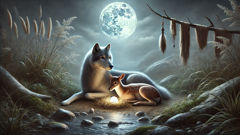
The pregnant months that followed were not easy. Whether myth or memory, the account insists upon the hardship because origin stories must honor the cost of being born into the world. The child grew within the doe's body, and the blue-grey wolf was a near-constant presence on the edge of the hollow: not a guardian in human terms but a living emblem of the land's watch. Soon the pace of migration, the shifting of seasons, and threats from other predators made the task of survival exacting. Wind tore at fur and hair, and cold seeped into bone during one early winter that the elders would later cite as a turning point. Yet through hunger and storm the child endured.
At birth, the newborn was not clearly one thing. He had the narrow face of a predator and the round, placid eyes of his maternal line. His teeth showed an early hardness; his legs had a spring meant for running and for leaping across gullies. But there was also a softness in his movement, a patience in his hunger that suggested the quiet grazing of the doe. That mixing was more than biology in the myths; it was the narrative engine for how a people could be both fierce and tender. The first ancestor—names vary across tellers—was said to make no claim to dominion at first. He learned, as all children do, by imitation and error. The wolves taught him to move in silence, to sense the weather in the fall of a leaf. The does taught him to listen to grass, to find water where it hides, and to shelter those who cannot flee.
When the child began to speak, he did not speak in a human tongue at once. The early soundings were hoots and howls, low calls akin to both the wolf and the doe, and only slowly did syllables shape into names. That slowness is important to the ethic encoded in the myth: patience is itself a kind of knowledge. The child grew and then walked—first a stumble, then a sure step—and with that movement came the first kin. Creatures attracted by the unusual lineage stayed near: a mare who found his presence soothing would later have foals that the people marked as blessed; a wandering herder would stop by the hollow, taste the salt the child offered, and carry away a tale that would enter a lineage of song. Each human who learned the story heard, in it, a permission to gather otherness into kinship.
As the child matured he accumulated gifts that later storytellers embroidered with omen and meaning. He had a voice that could move birds into flight or still a herd so mothers could call their young. He could walk into a storm and return with a clean scent, as if weather had become a friend. People began to leave offerings at the hollow: strands of horsehair, beads, bits of cloth dyed with natural ink, signs of respect to the being who embodied two natures at once. Shamans visited in ceremony, listening with bone and drum for the child's dreams. Over time, he learned to lead: not by command but by example. He showed where water lay beneath scoured soil, where wintergreens could be found, and how to make a shelter against steppe wind that would keep a newborn alive.
The child became a figure who could move between the life of hunter and the life of keeper. He taught the first humans to read shadow for the presence of wolves and to respect the doe's instinct to nurture. Through these teachings the group—part human, part animal in the retellings—developed the practices that would later hold communities together: communal sharing of meat, an ethic of taking only what the land could spare, rites for birth and death that invoked both wolf and doe. Thus the union was not a single event but a curriculum for living, a long apprenticeship by which a people learned to listen to storms and to sing the right songs for the harvest of fat-tailed sheep.
From the hollow by the river, the first ancestor led bands across ridges and through reed beds, and with each migration new people joined, drawn by story, by chance, or by the need to learn from one who seemed to know how to survive where the land was indifferent. Over generations—however the storytellers measured them—the descendants multiplied, adopting the symbols and the rituals that marked their origin. Each spring they would gather at the hollow to mark the union's anniversary, offering a portion of their herd and retelling the tale. The ritual kept the memory alive and reinforced the smoky, communal ethics that made the people durable on an open plain that tested the brave and the patient equally.
Tracks of Legacy: How a People Remember
Stories do what maps cannot: they trace invisible roads—obligations, temperaments, and the ways a community should hold itself. The myth of the wolf and the doe became, for the people of the steppe, a living map for conduct as much as identity. To remember the union was to rehearse commitments: to ride hard when necessary, and to heal with tenderness when the danger had passed. The descendants of that union learned to author themselves not just through conquest or lineage but through the continual act of remembering. In every winter camp a telling would be different, but the core persisted: there is a seed event when the land allowed kin to be born, and therefore the living owe the land a debt of respect.
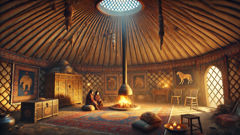
As bands expanded and coalesced into larger groups, the myth provided ritual scaffolding. Marriage rites included a whisper of the story: couples traced a small sign on each other's brow, a gesture like a wolf's bite softened into blessing. Naming ceremonies would often include a line that referenced the hollow by the river or the colors of the blue-grey coat. Children were taught to read the tracks in the mud: predator paths that demanded respect and grazing patterns that taught where the safest pastures lay. The rite of passage for young riders involved a test that echoed the mythic lessons: a night alone with only a small fire and the memory of both howling and grazing, a trial of resourcefulness and restraint. Those who passed returned with a new name or a token braided from horsehair to mark the initiation.
The social code that emerged from these stories emphasized balance. Leaders were expected to be as cunning as a wolf and as considerate as a doe. Courage was measured not by the ability to strike first but by knowing when not to strike at all, when to give up a kill to feed the clan, or when to hold back from a fight to preserve a future. Hospitality was central: a stranger was never turned away without food, for the ancestors themselves had been creatures who had been given shelter. At the same time, justice had teeth. The stories encoded forms of accountability; a leader who took more than his share, who used the myth as a mask for cruelty, would find himself isolated. Social memory could be sharp.
Names, songs, and horse culture all carried the echo of that first union. Horses—always pivotal to steppe life—were celebrated in ballads that compared a rider to a wolf in speed and a doe in steadiness. The horse's gait became a metaphor for governance and survival: a measured gallop for long campaigns, a sudden lunge for times of crisis. Shamans continued to play a role in mediating between human needs and the wild orders the myth spoke of; they read dreams that might be warnings from the wolf side and listened for seasons when the land, like the doe, needed tenderness and rest. When drought or plague came, the people turned to rituals that combined songs of hunting and songs of tending, as if in such a balance lay the cure.
Beyond ritual and social code, the story also shaped art and iconography. Artists carved wolves and does side by side in wooden panels that decorated yurts; craftsmen wove tapestries where a blue-grey animal's fur pattern echoed in the geometry of the design. These visual forms made the myth portable, so that even when people traveled far from the hollow they carried an image of their beginnings. Poetry, too, took on the mythic contour; poets wrote of nights when stars leaned close enough to listen, of the river that remembered names, and of the sorrow of leaving a motherland that is both generous and indifferent. Such lines passed into oral tradition and then, later, into written chronicles where they rubbed against other histories and acquired new hues.
What remains constant in the living memory is this: the myth gives people a language for the world’s complexity. It offers a template for interdependence that is useful in a place where weather can decide the fate of a breeding season and where alliances, once formed, must be maintained across generations. It also insists on tenderness as a political act. When survival requires harshness, the story reminds the listener that mercy is not weakness but a practiced power, taught to the people initially by a doe who knew how to carry and by a wolf who knew how to protect.
As centuries passed and history carried the people across new terrains and into new encounters, the story stayed with them. It altered in detail when neighboring peoples told it in other voices, but the core remained: a blue-grey wolf and a fallow doe met, and out of their meeting a lineage took shape that could survive the caprices of weather and time. That lineage carried with it obligations to the land and to those who crossed it—a code that held in its image both the wildness of hunting and the care of tending. Travelers who have the patience to listen can still hear traces of the myth in lullabies, in the names of places, and in the way elders lean toward a listener when the wind begins to tell its own version of an old tale. The myth remains, a weathered but serviceable map that helps people remember who they are and how they might be when the heavens demand it.
Conclusion
The myth of the blue-grey wolf and the fallow doe has stayed alive because it answers a human hunger for meaning that maps and facts alone cannot fill. It gives shape to a people's ethics and supplies a vocabulary for the choices of everyday life: how to ride, when to give, and what to keep. More than a quaint tale, the story operates like a communal memory that binds practical knowledge to moral imagination. It reminds listeners that identity is not only blood and name but also the lessons learned at the edge of weather: that courage without compassion becomes cruelty, and that tenderness without strength becomes vulnerability. Under the wide sky that first watched the meeting, descendants learned to balance both: to read winds and waterways, to sing to foals and to wolves alike, and to measure victory by what was preserved as much as by what was won. Today, in songs, in carved panels, and in the hush of night at a winter camp, the myth continues to be told. Each telling is a small act of honoring—a recognition that people do not arise from single events but from sequences of care, attention, and memory. The wolf and the doe were not merely the parents of a people; they were teachers, and their lesson endures: live sharply, give gently, and remember that your beginnings call you to owe the land and your neighbors what you can.

